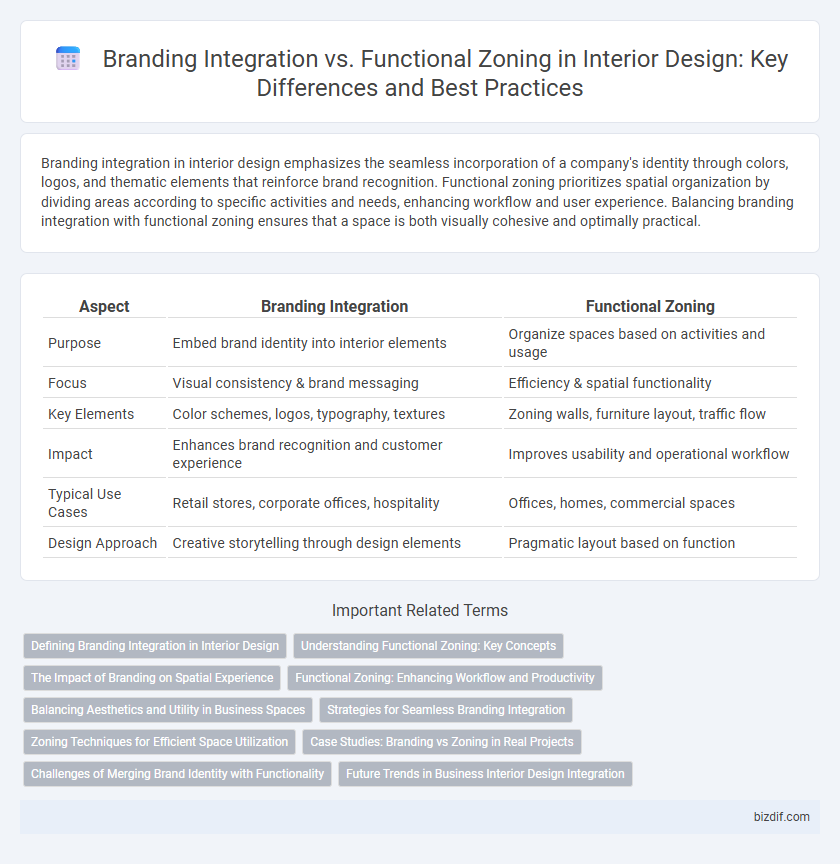Branding integration in interior design emphasizes the seamless incorporation of a company's identity through colors, logos, and thematic elements that reinforce brand recognition. Functional zoning prioritizes spatial organization by dividing areas according to specific activities and needs, enhancing workflow and user experience. Balancing branding integration with functional zoning ensures that a space is both visually cohesive and optimally practical.
Table of Comparison
| Aspect | Branding Integration | Functional Zoning |
|---|---|---|
| Purpose | Embed brand identity into interior elements | Organize spaces based on activities and usage |
| Focus | Visual consistency & brand messaging | Efficiency & spatial functionality |
| Key Elements | Color schemes, logos, typography, textures | Zoning walls, furniture layout, traffic flow |
| Impact | Enhances brand recognition and customer experience | Improves usability and operational workflow |
| Typical Use Cases | Retail stores, corporate offices, hospitality | Offices, homes, commercial spaces |
| Design Approach | Creative storytelling through design elements | Pragmatic layout based on function |
Defining Branding Integration in Interior Design
Branding integration in interior design involves embedding a company's visual identity, values, and message into the physical environment to create a cohesive and immersive brand experience. This approach uses colors, materials, logos, and spatial arrangements that reflect the brand's personality and reinforce recognition among clients and employees. Unlike functional zoning, which prioritizes optimizing space for practicality and workflow, branding integration aims to strengthen emotional connections and brand loyalty through intentional design elements.
Understanding Functional Zoning: Key Concepts
Functional zoning in interior design divides spaces based on their specific uses, enhancing efficiency and comfort by clearly defining areas for living, working, or relaxing. Understanding key concepts of functional zoning involves analyzing traffic flow, activity patterns, and spatial relationships to optimize usability and maintain a cohesive environment. Integrating branding elements within these zones reinforces identity without compromising the functionality and purpose of each distinct area.
The Impact of Branding on Spatial Experience
Branding integration transforms spatial experience by embedding visual identity and brand values into interior design elements, creating a cohesive environment that resonates with users. Functional zoning optimizes space utility but may lack emotional connection without strategic branding cues that guide user interaction and perception. Effective branding enhances spatial storytelling, elevating user engagement beyond mere functionality.
Functional Zoning: Enhancing Workflow and Productivity
Functional zoning in interior design strategically organizes spaces to enhance workflow and productivity by clearly defining areas according to specific tasks. This approach minimizes distractions and streamlines movement, promoting efficiency in both residential and commercial environments. Incorporating ergonomic layouts within functional zones further supports occupant comfort and maximizes operational effectiveness.
Balancing Aesthetics and Utility in Business Spaces
Balancing aesthetics and utility in business spaces requires seamless branding integration alongside functional zoning, ensuring each area reflects the company's identity while optimizing workflow. Strategic placement of branded elements enhances visual appeal without compromising practical use, promoting an inviting yet efficient environment for employees and clients. Effective interior design harmonizes these aspects to elevate brand presence and operational performance simultaneously.
Strategies for Seamless Branding Integration
Seamless branding integration in interior design leverages consistent color schemes, logos, and typography across all zones to reinforce brand identity while maintaining functional zoning. Implementing tailored lighting and material choices enhances spatial differentiation without compromising brand cohesion. Strategic placement of branded elements within functional zones ensures an immersive and cohesive customer experience.
Zoning Techniques for Efficient Space Utilization
Zoning techniques for efficient space utilization in interior design involve creating distinct areas that serve specific functions while maintaining cohesive branding elements throughout. Functional zoning optimizes workflow and comfort by clearly delineating spaces based on activities, such as workstations, relaxation areas, and meeting zones. Integrating branding within these zones strengthens visual identity and user experience by incorporating brand colors, logos, and thematic decor tailored to each functional area.
Case Studies: Branding vs Zoning in Real Projects
Case studies in interior design reveal that branding integration enhances spatial identity by incorporating logo colors, typography, and thematic elements directly into design features, creating cohesive customer experiences that reinforce brand recognition. Functional zoning prioritizes spatial efficiency and user flow, organizing areas based on specific activities such as work, relaxation, or social interaction, which optimizes operational performance and comfort. Real projects demonstrate a successful balance where branding elements subtly influence zoning decisions, ensuring both strong brand presence and functional usability without compromising either aspect.
Challenges of Merging Brand Identity with Functionality
Merging brand identity with functional zoning presents challenges in maintaining design consistency while ensuring practical space usage. Designers must balance strong visual branding elements, such as color schemes and logos, with ergonomic layouts that support user needs and workflow efficiency. Overemphasis on branding can compromise functionality, leading to decreased occupant comfort and productivity.
Future Trends in Business Interior Design Integration
Future trends in business interior design highlight a seamless fusion of branding integration and functional zoning, where spatial layouts not only enhance operational efficiency but also vividly communicate brand identity. Advanced technologies like AR and AI enable dynamic space customization, reflecting evolving company values and enhancing employee engagement. Sustainable materials and biophilic design elements support eco-conscious branding while promoting well-being, setting new standards in corporate interiors.
Branding integration vs Functional zoning Infographic

 bizdif.com
bizdif.com